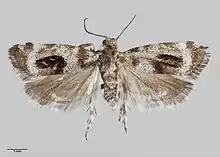Asterivora inspoliata
Asterivora inspoliata is a species of moth in the family Choreutidae.[1] It is endemic to New Zealand and has been found in the southern parts of the South Island. Adults are on the wing in December and January.
| Asterivora inspoliata | |
|---|---|
 | |
| Male holotype specimen held at the Auckland War Memorial Museum. | |
| Scientific classification | |
| Kingdom: | |
| Phylum: | |
| Class: | |
| Order: | |
| Family: | |
| Genus: | |
| Species: | A. inspoliata |
| Binomial name | |
| Asterivora inspoliata | |
| Synonyms[2] | |
| |
Taxonomy
.jpg.webp)
This species was first described by Alfred Philpott in 1930, using a specimen collected by C. E. Clarke at Flat Mountain, Hunter Mountains in December at 4,000 feet (1,200 m), and named Simaethis inspoliata.[3] In 1939 George Hudson discussed and illustrated this species under that name.[4] In 1979 J. S. Dugdale placed this species within the genus Asterivora.[5] In 1988 Dugdale confirmed this placement.[2] The male holotype specimen, collected at Flat Mountain, is held at the Auckland War Memorial Museum.[2]
Description
.jpg.webp)
Philpott described this species as follows:
♂. 10 mm. Head and thorax dark brown. Pace grey. Palpi, second segment with dense rounded descending tuft, grey. Antennae black spotted with white, ciliations in ♂ 3+1⁄4. Abdomen greyish fuscous. Legs dark fuscous, mixed and banded with white. Porewings with costa slightly arched, apex rounded, termen almost straight, oblique; brown; markings formed chiefly by dense white irroration; a small irregular basal patch; a broad band from 1⁄5 to 1⁄2 costa and 1⁄4 to 1⁄2 dorsum, its inner edge slightly incurved and its outer margin irregular; a broad fascia from costa at 3⁄4 to tornus, constricted beneath costa and somewhat excurved; a thin subterminal line white on costa and metallic blue round termen: between second and third fasciae on lower half of wing a large black blotch enclosing two small patches of metallic blue scales: fringes brown, touched with white at tornus and with a darker basal line. Hindwings pale purplish brown, lighter towards apex; a rather obscure white fascia from tornus reaching about half way round termen and keeping close to the margin: fringes brown, more or less white-tipped and with a darker basal line.[3]
Distribution
This species is endemic to New Zealand and has been found in subalpine habitat in the hills and mountains of Otago, Fiordland and Southland.[2][6]
References
- Gordon, Dennis P., ed. (2010). New Zealand inventory of biodiversity: Kingdom animalia : chaetognatha, ecdysozoa, ichnofossils. Vol. 2. p. 457. ISBN 978-1-877257-93-3. OCLC 973607714. OL 25288394M. Wikidata Q45922947.
- John Stewart Dugdale (23 September 1988). "Lepidoptera - annotated catalogue, and keys to family-group taxa". Fauna of New Zealand. Department of Scientific and Industrial Research. 14: 113. doi:10.7931/J2/FNZ.14. ISSN 0111-5383. Wikidata Q45083134.
- Philpott, Alfred (1930). "New Species of Lepidoptera in the Collection of the Auckland Museum". Records of the Auckland Institute and Museum. 1: 12. ISSN 0067-0464. JSTOR 42905932. Wikidata Q58676529.
- George Vernon Hudson (1939), A supplement to the butterflies and moths of New Zealand, Illustrator: George Hudson, Wellington, p. 457, OCLC 9742724, Wikidata Q109420935
{{citation}}: CS1 maint: location missing publisher (link) - J. S. Dugdale (July 1979). "A new generic name for the New Zealand species previously assigned to Simaethis auctorum (Lepidoptera: Choreutidae), with description of a new species". New Zealand Journal of Zoology. 6 (3): 461–466. doi:10.1080/03014223.1979.10428386. ISSN 0301-4223. Wikidata Q54576372.
- "Asterivora inspoliata Philpott, 1930". www.gbif.org. Retrieved 2022-02-04.